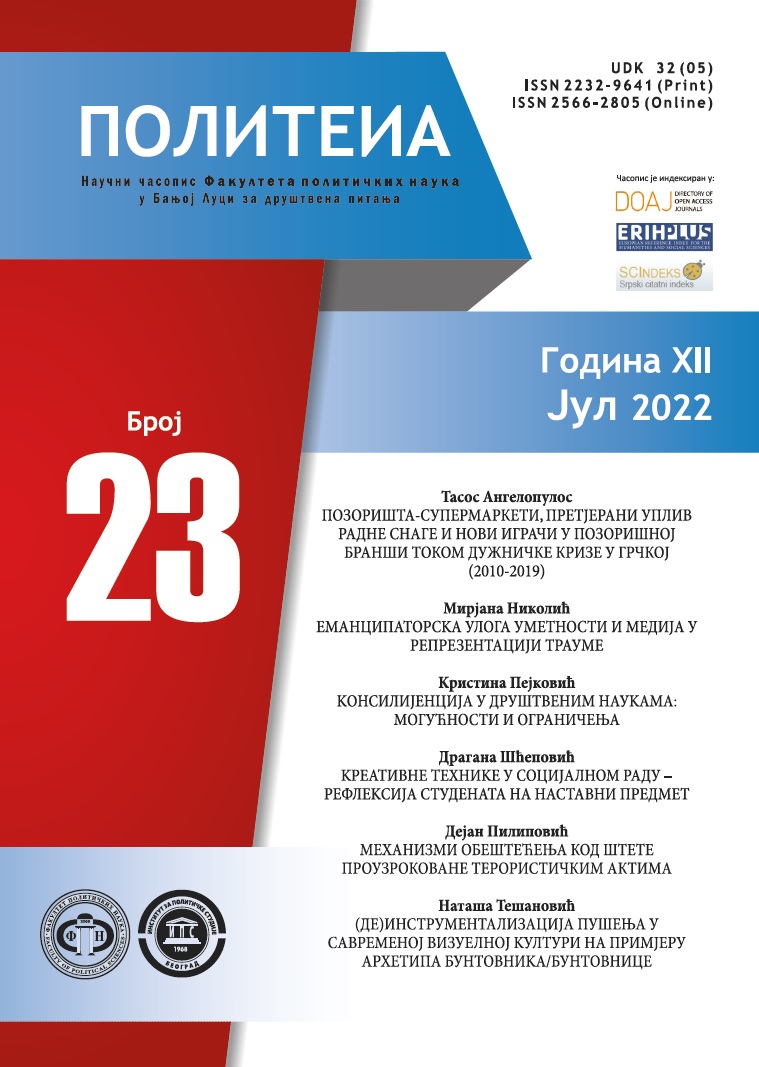EMANCIPATORSKA ULOGA UMETNOSTI I MEDIJA U REPREZENTACIJI TRAUME
Sažetak
Umetnost i mediji imaju značajnu ulogu u reprezentaciji stvarnosti i neretko su tokom svoje istorije bili moćno sredstvo u ostvarivanju ciljeva društvenih i političkih elita. Nije retka pojava da su u totalitarnim režimima i u kriznim društvenim situacijama polagali apsolutno pravo na istinu delujući kao sredstva propagande, utiskujući željene ideje u svest građana kao publike. Brojni su tekstovi u kojima su predstavljeni i analizirani kapaciteti umetnosti i medija kako u smislu angažovanosti tako i u smislu manipulativnosti. Polazeći od teorijskih stavova Žaka Ransijera (emancipovani gledalac) i H. M. Encensberger (emancipatorska uloga medija), u radu će se analizirati sadejstvo umetnosti i medija u procesu reprezentacije prošlosti posebno kada je ona izvor traumatičnih iskustava. Jedno od takvih iskustava vezano je za Holokaust kao izvor globalne i niza individualnih trauma. Preko konkretnih primera uočenih u oblastima radio-drame, filmske umetnosti i medijima, u radu ćemo pokušati da preispitamo kapacitete umetničkih formi i medijskog teksta u reprezentaciji trauma, odnosno njihovim mogućnostima da publici prenesu stravične događaje iz prošlosti. Da li je suština umetničkog dela u prenošenju traumatičnih iskustava ili je ono „rampa“, granica, linija odbrane publike s obzirom na to da je i u svom najnaturalizovanijem obliku umetničko delo blaže i umerenije od realnosti na koju referiše. Кljučne studije slučaja u analizi postavljenih hipoteza biće dva umetnička, medijska teksta, oba iz 1985. godine: film Šoa (Кlod Lancman) i radio-drama Traganje po pepelu (Đorđe Lebović/ Slobodan Boda Marković).
Reference
Encensberger, H. M. (1980). Nemačka, Nemačka između ostalog. Beograd: Bigz.
Lošonc, M i Krstić, P. (ur.) (2018). Holokaust i filozofija. Beograd: Institut za filozofiju i društvenu teoriju.
Mek Kvin, D. (2000). Televizija. Beograd: Clio.
Nikolić, M. (2017). Polifonijska unisonost interneta kao medija masovne samokomunikacije. Medijski dijalozi, 10 (27/28), 201‒212.
Nikolić, M. (2014). The Arst of Radio drama as a representation of the Holocaust: „Searching in Ashes“, Radio Beograd (1985. In N. Daković (Ed.), Representation of the Holocaust in the Balkans in Arts and Media (pp. 49‒53). Belgrade: Faculty of Dramatic Arts.
Ransijer Ž. (2010). Emancipovani gledalac. Beograd: Biblioteka Sveske.
Ransijer, Ž. (2013). Sudbina slika, Podela čulnog. Beograd: Fakultet za medije i komunikacije.
Ray, G. (2005). From Auschwitz to Hiroshima to September 11. New York: Palgrave.
Selenić, S. (prir.). (1977). Antologija savremene srpske drame. Beograd: Srpska književna zadruga.
Šprah, A. (n.d.). Reprezentacije holokausta: (ne)mogućnost reprezentacije nepodnošljivih slika. Staro sajmište Info. Posećeno 11. 07. 2021. URL: http://starosajmiste.info/userfiles/files/transcripts/transkript_andrej_sprah_(ne)mogucnost_reprezentacije_nepodnosljivih_slika.doc.
Autori koji objavljuju u ovom časopisu pristaju na sljedeće uslove:
- Autori zadržavaju autorska prava i pružaju časopisu pravo prvog objavljivanja rada i licenciraju ga "Creative Commons Attribution licencom" koja omogućava drugima da dijele rad, uz uslov navođenja autorstva i izvornog objavljivanja u ovom časopisu.
- Autori mogu izraditi zasebne, ugovorne aranžmane za neekskluzivnu distribuciju članka objavljenog u časopisu (npr. postavljanje u institucionalni repozitorijum ili objavljivanje u knjizi), uz navođenje da je članak izvorno objavljen u ovom časopisu.
- Autorima je dozvoljeno i podstiču se da postave objavljeni članak onlajn (npr. u institucionalni repozitorijum ili na svoju internet stranicu) prije ili tokom postupka prijave rukopisa, s obzirom da takav postupak može voditi produktivnoj razmjeni ideja i ranijoj i većoj citiranosti objavljenog članka (Vidi Efekti otvorenog pristupa).

